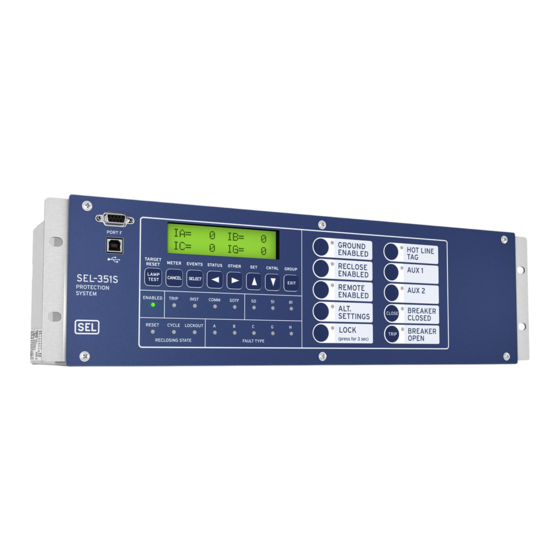
Sel SEL-351S-5 Manuals
Manuals and User Guides for Sel SEL-351S-5. We have 1 Sel SEL-351S-5 manual available for free PDF download: Instruction Manual
Sel SEL-351S-5 Instruction Manual (760 pages)
Relay, Meter, Control, Fault Locator
Table of Contents
-
Preface18
-
Applications28
-
Rack Mount38
-
Panel Mount38
-
Power Supply53
-
Serial Ports60
-
Torque Control105
-
Voltage Elements113
-
Setting SYNCP122
-
Setting ELOP155
-
Setting ELOP = y156
-
Setting ELOP = N156
-
Internal Enables167
-
Unlatch Trip214
-
Trip Setting DTT224
-
External Inputs226
-
Timer Settings227
-
Logic Outputs227
-
Set Close251
-
Unlatch Close252
-
Reclosing Relay263
-
Lockout State265
-
Reset Timer268
-
Input Functions285
-
On/Off Switch287
-
Feedback Control295
-
Push Button301
-
Settings Change307
-
Settings Example310
-
Output Contacts313
-
Control Strings332
-
Introduction334
-
Breaker Monitor335
-
Via Serial Port345
-
Demand Metering353
-
Time = 0 Minutes356
-
Time = 5 Minutes356
-
Energy Metering362
-
Recloser Curves377
-
Line Settings425
-
Settings Sheets428
-
Relay Settings430
-
Other Settings443
-
Power Elements444
-
Other Equations452
-
Local Bit Labels460
-
Access Level B476
-
Command Summary510
-
Introduction514
-
Introduction544
-
Fault Location548
-
SER Triggering568
-
Introduction588
-
Relay Self-Tests596
-
Overview618
-
Start SEL625
-
Operation642
-
Message Lists645
-
DNA Message655
-
BNA Message657
-
SNS Message657
-
Relay Word Bits677
-
Overview692
-
Configuration693
-
Device Profile698
-
Object Table700
-
Data Map705
-
Point Remapping711
-
Operation718
-
Loopback Testing719
-
Settings722
-
Introduction726
-
Introduction734
-
Installation736
-
Overview738
-
Introduction739
-
Settings745
-
Elements753
-
Display754
Advertisement
Advertisement
